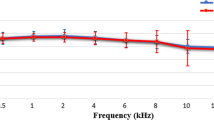Summary
In the majority of cases tinnitus has a high pitch and can be matched rather precisely to an objective high frequency sound. However, it is well known that tinnitus can be masked by different tones without any frequency selectivity. We wondered whether objective tones matched to tinnitus would show a more significant deterioration of frequency selectivity than could be expected from any associated hearing loss. Psychoacoustic tuning curves were obtained using simultaneous pure-tone masking and revealed a broadening of frequency selectivity. In cases of comparable bilateral hearing losses with unilateral tinnitus, the broadening associated with the tinnitus was particularly conspicuous. This broadening strongly suggests that tinnitus originates in the cochlea, although some involvement of central pathways may also occur. Tinnitus-induced broadening of frequency selectivity as a possible sign of cochlear origin deserves further consideration in future studies.
Similar content being viewed by others
References
Cazals Y, Bourdin M (1983) Etude acoustique des acouphènes. Rev Laryngol 104:433–438
Cazals Y, Li XQ, Aurousseau C, Didier A (1988) Acute effects of noradrenalin related vasoactive agents on the ototoxicity of aspirin: an experimental study in the guinea pig. Hear Res 36:89–96
Dauman R, Cazals Y, Aran JM (1988) Frequency selectivity: reliability of electrocochleographic measures with isointensity masking. Acta Otolaryngol (Stockh) 105:50–55
Douek E (1987) Tinnitus following surgery. In: Feldmann H (ed) Proceedings of the Third International Tinnitus Seminar, Münster 1987. Harsch Verlag, Karlsruhe, pp 64–69
Douek E, Reid J (1968) The diagnostic value of tinnitus pitch. J Laryngol Otol 82:1039–1041
Evans EF, Borerwe TA (1982) Ototoxic effects of salycilates on the responses of single cochlear nerve fibers and on cochlear potentials. Br J Audiol 16:101–108
Feldmann H (1971) Homolateral and contralateral masking of tinnitus by noise-bands and by pure-tones. Audiol 10:138–144
Feldmann H (1988) Pathophysiology of tinnitus. In: Kitahara M (ed) Tinnitus: pathophysiology and management. IgakuShoin, Tokyo, pp 7–35
Florentine M, Buus S, Sharf B, Zwicker E (1980) Frequency selectivity in normally-hearing and hearing-impaired listeners. J Speech Hear Res 23:646–669
Hawkins JE Jr (1979) Ototoxicity. In: Maran AG, Stell PM (eds) Clinical otolaryngology. Blackwell, Oxford, pp 92–9911
Kiang NYS, Liberman MCh, Sewell WF, Guinan JJ (1984) Single unit clues to cochlear mechanisms. Hear Res 22:171–182
Miller MH, Jakinetz JR (1984) Noise exposure, hearing loss, speech discrimination and tinnitus. J Laryngol Otol [Suppl] 9:74–76
Mongan E, Kelly P, Nies K, Porter WW, Paulus HF (1973) Tinnitus as an indicator of therapeutic serum salicylate levels. JAMA 226:142–145
Sasaki CT, Kauer JS, Babitz L (1980) Differential [14C] 2 Deoxyglucose uptake after deafferentation of the mammalian auditory pathway — a model for examining tinnitus. Brain Res 194:511–516
Spoendlin H (1987) Inner ear pathology and tinnitus. In: Feldmann H (ed) Proceedings of the Third International Tinnitus Seminar, Münster 1987. Harsch Verlag, Karlsruhe, pp 42–51
Stelmachowicz PG, Jesteadt W (1984) Psychophysical tuning curves in normal-hearing listeners: test reliability and probe level effects. J Speech Hear Res 27:396–402
Tyler RS, Conrad-Armes D (1984) Masking of tinnitus compared to masking of pure tones. J Speech Hear Res 27:106–111
Vernon J (1988) Measurement of tinnitus: an update. In: Kitahara M (ed) Tinnitus: pathophysiology and management. Igaku-Shoin, Tokyo, pp 36–52
Wightman FL, McGee T, Kramer M (1977) Factors influencing frequency selectivity in normal and hearing impaired listeners. In: Evans E, Wilson JP (eds) Psychophysics and physiology of hearing. Academic Press, London, pp 295–306
Zwicker E (1974) On a psychoacoustical equivalent of tuning curves. In: Zwicker E, Terhardt (eds) Facts and models of hearing. Springer, New York Berlin Heidelberg, pp 132–141
Zwicker E (1987) Masking in normal ears — psychoacoustical facts and physiological correlates. In: Feldmann H (ed) Proceedings of the Third International Tinnitus Seminar, Münster 1987. Harsch Verlag, Karlsruhe, pp 214–223
Author information
Authors and Affiliations
Rights and permissions
About this article
Cite this article
Dauman, R., Cazals, Y. Auditory frequency selectivity and tinnitus. Arch Otorhinolaryngol 246, 252–255 (1989). https://doi.org/10.1007/BF00463566
Issue Date:
DOI: https://doi.org/10.1007/BF00463566




